| Introduction |
This special issue of the N2Africa Podcaster is devoted to updates from each of the PhD students being funded through N2Africa. Dr Amaral Chibeba from Mozambique is the only student to have completed his PhD so far, although we expect several more to complete in the coming months. Your comments and suggestions on the ongoing projects are most welcome.
Ken Giller
|
1 |
| Dotting the i’s and crossing the t’s in Kenya |
|
My research project has assessed the diversity and symbiotic effectiveness of bacteria nodulating beans in different agro-ecological zones in Kenya, developed a gene-marker system for rapid analysis of nodule occupancy and evaluated the effect of several factors, such as soil nitrogen, on strain nodule occupancy outcomes. ...
Photo: Effective bean nodules
|
 |
|
2 |
| Exploring the genetic diversity of groundnut-nodulating rhizobia in moist and dry savannas in Nigeria for increased symbiotic nitrogen fixation and productivity |
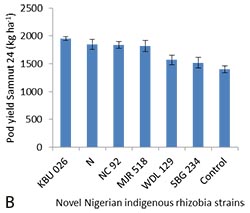 |
The aim of my study is to unravel the types, nature, genetic diversity and effectiveness of groundnut-nodulating rhizobia existing in different soil types of the moist; northern Guinea (NG) and dry; Sudan (S) savannas of Nigeria, with a view to identify strains that hold promise for improved symbiotic N2-fixation, productivity and soil fertility. ...
Figure: combined performance of selected novel Nigerian indigenous rhizobia strains in both northern Guinea and Sudan savannas of Nigeria ...
|
|
3 |
| Genetic and symbiotic effectiveness of indigenous rhizobial strains and strategies to maximize the contribution of biological nitrogen fixation on soyabean in Mozambique |
|
The objectives of this study were to characterize indigenous rhizobia and to identify strains that hold potential to be included in inoculants for soyabean production in Mozambique. ...
Photo: Amaral Chibeba (center), supervisors and panel members
|
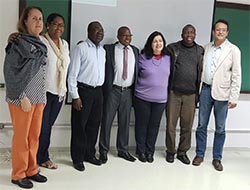 |
|
4 |
| Examining indigenous soyabean rhizobia populations for inoculant use in Zimbabwe |
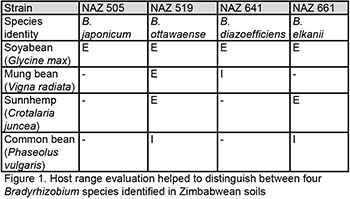 |
Rhizobia inoculants form the backbone of soyabean production, which is important in Zimbabwe’s agriculture led economy. Traditionally, soyabean production is carried out with the use of elite, but exotic, rhizobia inoculant strains. It has been established in previous studies (Zengeni et al., 2003; Zengeni et al., 2006) that these strains do not persist well in the fields, and require frequent inoculation.
|
|
5 |
| Response of groundnut (Arachis hypogaea L.) varieties to rhizobia inoculation in the Sudan and northern Guinea savannas of Nigeria |
|
The aim of my study is to explore the use of rhizobia inoculation in order to increase yield and biological nitrogen fixation of the selected groundnut genotypes in the Sudan and northern Guinea savannas of Nigeria. Last year, I have already started the field work with two experiments. ...
Photo: Faruk Showing his visitors round in the groundnut fields in Bayero University, Nigeria
|

|
|
6 |
| Assessment of improved cowpea varieties cultivated by women farmers in southern part of Borno State, Nigeria |
 |
This study examined the impact of improved cowpea varieties on the income and the food security status of women farmers in southern part of Borno State, Nigeria. ...
Left: Part of the table on food security measures among women households in PROSAB area included in this update
|
|
7 |
| Comparing yields and some yield components of common bean from intercropping and rotations with maize in the northern highlands of Tanzania |
|
The aim of my study is to unravel the contributions of genetic, environmental and management related factors to common bean yield and nitrogen fixation. I am conducting a continuous cropping study, which involves rotations and intercropping of common bean with maize for six seasons and compare the performance of two bean varieties; namely improved Lyamungu 90 and local Mkanamna. ...
Gladness Pius Lema, a trained casual labour, assisting Eliakira Kisetu in counting bean grains at harvest in Hai district, Tanzania
|
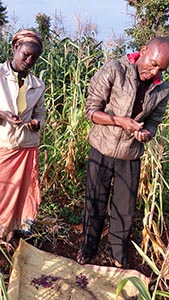 |
|
8 |
| Co-design and implementation of improved climbing bean technologies in Uganda |
 |
A lot has happened since last year: the first paper of my PhD, entitled Understanding variability in soyabean yield and response to P-fertilizer and rhizobium inoculants on farmers’ fields in northern Nigeria got published in Field Crops Research (Podcaster 34), I largely finished the data collection in Uganda and I have entered the final year of my PhD, so I will focus on writing up the results. ...
Photo: Data collection in field of climbing beans, intercropped with banana and cassava (Kapchorwa, Uganda, 2014)
|
|
9 |
| Common bean seed multiplication and isolation of rhizobia nodulating common bean in Ethiopia |
|
In order to examine the interaction between bean genotypes and rhizobium strains nodulating bean, seed of 29 different bean varieties that represent a great genetic diversity were obtained from CIAT, Colombia. They were multiplied in a screenhouse on soil samples collected from potential bean growing areas in Sidama, Ethiopia. ...
Picture: Strains growing on YMA-BTP
|
 |
|
10 |
| Genotype x Environment interaction in soyabean breeding under rhizobia inoculation in the savanna region of Nigeria |
 |
Despite the importance of soyabean in Nigeria, yields on farmers’ fields have remained relatively low. The crop holds considerable potential for arresting soil fertility decline and enhancing household food nutrition. Therefore, this study aimed to exploit differences among soyabean genotypes, assess genotype environment effect on seed yield and rhizobia inoculation as a means of improving nitrogen fixation and productivity of soyabean across three locations in the savanna region of Nigeria. ...
Picture: Kehinde Tolorunse masuring the chlorophyll content using the spad meter for the purpose of determining the greenish of the leaves
|
|
11 |
| Indigenous status of rhizobia in Nigeria: Does this aid its symbiotic performance with cowpea? |
|
The success of cowpea response to inoculation with effective rhizobia strain in presence of indigenous rhizobia depends on three factors; population density, effectiveness and competitive ability of native African rhizobia. ...
Picture: (A) Growing rhizobia strains, (B) Ojo Comfort in the greenhouse with growing cowpea and (C) growth response of cowpea to three different treatments
|
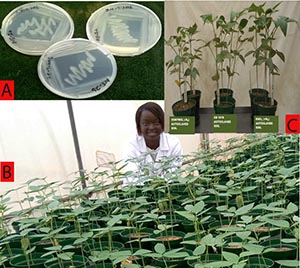 |
|
12 |
| Assessing the need for rhizobial inoculation of cowpea in Nigeria savannas |
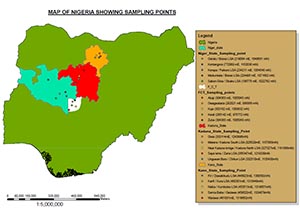 |
Cowpea (Vigna unguiculata) is a major staple in Nigeria. Despite this, its yield has remained low at 450 kg ha-1 (Omotosho, 2014). ...
Figure: Map of locations in Nigeria Savannas where soil samples were collected
|
|
13 |
| Exploring options to enhance biological nitrogen fixation and yield of soyabean and common bean in smallholder farming systems in Rwanda |
|
One of my major research activities was a set of trials that evaluated the role of inoculation, P-fertilizer and manure application on common bean and soyabean yield and yield components. As part of this work, I measured nitrogen fixation in both legumes using the 15N-natural abundance method.
Picture: Soyabean inoculated, with P-fertilizer and manure in Bugesera
|
 |
|
14 |
| Maize-grain legume intercropping: Ecological intensification to enhance resource use efficiency and crop productivity for smallholder farmers in northern Ghana |
|

|
I conducted intercropping trials as key part of my PhD study, for the 2013 and 2014 seasons in the southern (Kpataribogu) and northern (Bundunia) Guinea savanna in northern Ghana. ...
Figure: Cowpea and maize grain yields as affected by spatial plant arrangement and soil fertility level in 2013 in Kpataribogu and Bundunia. The error bars show the standard error of difference between means (SED)
|
|
15 |
| Abundance and morphological characteristics of rhizobia nodulating common bean in Uganda |
|
We used the plant infection technique to estimate the population of rhizobia in soils obtained from the Montane and Mt. Elgon agro-ecological zones (AEZs), focusing on three land use management practices across an elevation gradient. ...
Figure: Sterile nutrient solution addition during authentication tests of the isolates in a growth chamber
|

|
|
16 |
| Grain legume residues: Livestock fatteners’ most vital feed resource in northern Ghana |
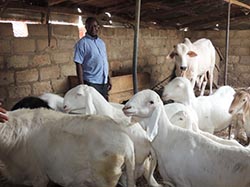 |
Livestock fattening is one of the major occupations of the people of Bawku in the Upper East Region of Ghana. It is a business considered to be for landless people in the society. Bawku is one of the project districts of the N2Africa project. ...
Figure: Mr Abdala Awal with some of his fattened animals ready for the market
|
|
17 |
| Nutritional benefits of improved grain legume cultivation in Ghana and Kenya |
|
n contrast to my first PhD period within the N2Africa project, last year I spent most of my time behind my desk analysing data, discussing results with others and writing. I hope to soon share with you my first paper ‘Child’s nutritional benefits of improved grain legume cultivation in smallholder farming households in rural Ghana and Kenya’. ...
Figure: Explorative structural equation model of the effect of soyabean production on dietary diversity of children 6-59 months through production-own consumption pathway and income-food purchase pathway in rural western Kenya
|
 |
|
18 |


















